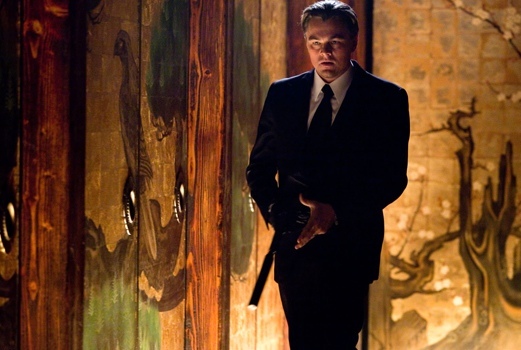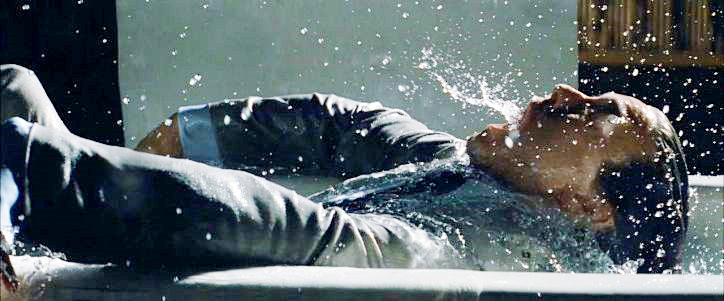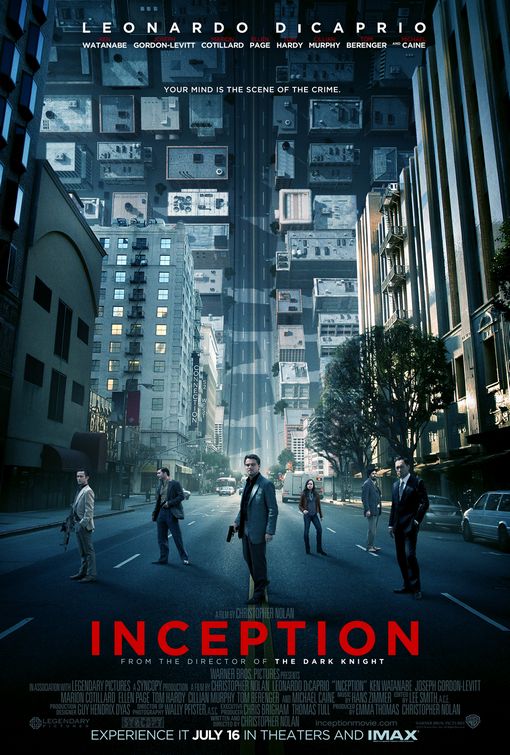
Dreams wrapped inside dreams, riddles wrapped inside riddles. Inception is the brainiest blockbuster in many a moon, selecting to confuse and bewilder its audience deliberately, not because it doesn’t know what it’s doing but because it’s a Pandora’s Box that chooses to keep you guessing. Director Christopher Nolan (the extraordinary talent behind “Memento,” “The Dark Knight”) doesn’t just want to keep you guessing, he wants you to keep deconstructing the intersecting puzzles he has created for the screen – the brainteaser work never rests. Nolan presents multiple threads of reality, or dream stories, toppling over each other, ripples linking to each other, throttling the narrative forward and explaining little. The film is as aggravating as it is enthralling.
The futuristic technology is not fully explained and the multi-national corporations are faceless, but Leonardo DiCaprio is a virtual dreamcatcher named Cobb, hired to steal ideas from competitors by infiltrating their minds. His target in the first chapter is Saito (Ken Watanabe), but his mind has a defense safeguard, and near impossible to purge. Saito now hires Cobb to work for him, this time to not extract but to plant ideas inside the head of rival corporate raider Robert Fischer, Jr. (Cillian Murphy), heir to his dying father, to surrender his financial empire. “Ideas grow on the mind like cancer,” Cobb says.

Other espionage members, all on the legit, include Arthur (Joseph Gordon-Levitt), Eames (Tom Hardy), Yusuf (Dileep Rao), and new collegiate analyst Ariadne (Ellen Page) – all specialists in the art of deception and brain pathology. You also need these characters to spout quick philosophical and theoretical references, but their most valuable commodity is to explain the subconscious to the audience. As a final staple, you have Michael Caine as a professor, and as you might know, Caine shows up in every Nolan film, acting with restraint and bearing himself as perhaps keymaster to the mystery.
As a rule, five minutes of sleeping equals one hour in the dreamworld. When Cobb hacks into other people’s minds, he can spend an hour navigating the mind within. Other people within the dreamworld are “projections” and if a person dies within their dream than they can awaken in the real world. When Fischer, or any other mark, become aware that it is just a dream they try to make themselves dead, pointing guns at their own skulls, and Cobb within the dream does what he can to thwart suicide. Guys like Fischer, by the way, experience eternal threats within their subconscious.
While inside Fischer’s paranoid and violent-addicted head, this leads to permeating violence within the four interlinking dream stories in the final third (a proposed explanation: to keep the illusion consistent to Fischer all the dreams toppling each other have to inflect each other). Nolan circumnavigates between a white truck falling into the bay, a swank hotel room that turns into zero gravity exploits for Arthur who attempts to simulate free-falling for other sleepers, a snow summit stock with machinegun soldiers on skis and a secret vault, and a row of personal history architecture in a decimated fantasy city.

All of these bits hinge on each other in exploitive complexity, but it is Nolan cranking up the filmmaking wizardry: the slow-motion on the white truck, the allusions to “2001: Space Odyssey” in the hotel corridors and elevator, the snow summit choreographed like a James Bond invasion and more allusions to “2001” once inside the vault, and imaginary row of ersatz architecture built on subconscious projections that feels out of the Alex Proyas’ film “Dark City.”
 Nolan also uses the symbolic object of a thimble in the same way that Ridley Scott used a unicorn in “Blade Runner,” and when Nolan nods the camera on the object in the final shot he is telling his audience more than he is telling his own character what his surroundings signify. But if we back step a moment and fall into a criticism, the action at the snow summit feels rather gratuitous after awhile. We know it is part of Fischer’s subconscious (or whatever) to crop up violent projection characters, but these dreams feel more belonging to an ultra-modern century Warner Bros. action picture than it does from a character.
Nolan also uses the symbolic object of a thimble in the same way that Ridley Scott used a unicorn in “Blade Runner,” and when Nolan nods the camera on the object in the final shot he is telling his audience more than he is telling his own character what his surroundings signify. But if we back step a moment and fall into a criticism, the action at the snow summit feels rather gratuitous after awhile. We know it is part of Fischer’s subconscious (or whatever) to crop up violent projection characters, but these dreams feel more belonging to an ultra-modern century Warner Bros. action picture than it does from a character.

Hans Zimmer, composer
The music score by Hans Zimmer is pulsating and throbbing in the same spectacular way that “The Dark Knight” was, and the production design by Guy Dyas is so good that he would have been worthy to have been on the production team of “2001” or “Blade Runner” had he a career that went back that far (Dyas helmed the production design on the last Indiana Jones picture), the particular highlight, is the origami city of a new re-imagining of Paris, France. There is hardly a second that goes by that isn’t memorably traced to Zimmer or Dyas’ touch on this production.
An emotional backbone supports all this eye candy with the inclusion of Marion Cotillard (she was Billie Frechette in “Public Enemies”) as Mal, the former wife to Cobb who supposedly at one point could not tell the difference between dreams and reality following what one could describe mildly as, she had a deep sleep. Now she permeates through all of Cobb’s dreams, and then whenever infiltrates and shares dreams with others. Coincidentally, the character of the fallen wife is similar to that in “Shutter Island,” also with DiCaprio haunted twice now by recent past withered love. This is not a case of DiCaprio forcing motifs in all of his pictures. DiCaprio just merely selects good scripts, or gets lucky by good scripts, and gets chosen by top-notch directors like Nolan and Martin Scorsese, whom themselves are not trying to compete with each other.
Some movies require a bottle of wine (if it’s a chick flick), some action movies require a six-pack of beer shared between friends, and “Inception” is a rare movie that requires three cups of coffee. Maybe not just for the morning after, but three cups a day for a week, consulting your friends at Starbucks and together going over what you think you know about “Inception.” A $160 million Warner Bros. picture that’s adventure and mindbender has been made, a super rarity if there ever was one, and you might as well have something to talk about for the rest of the summer. Aggravating it may well be, but there won’t be another movie this layered to talk about for a very long time.
148 Minutes. Rated PG-13.
THRILLER / MIND-BENDER / WEEKEND PARTY GET-TOGETHER
Film Cousins: “Blade Runner” (1982); “The Matrix” (1999); “eXistenZ” (1999); “Memento” (2001).





